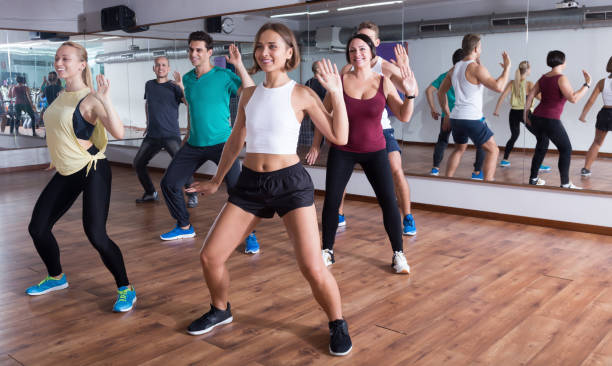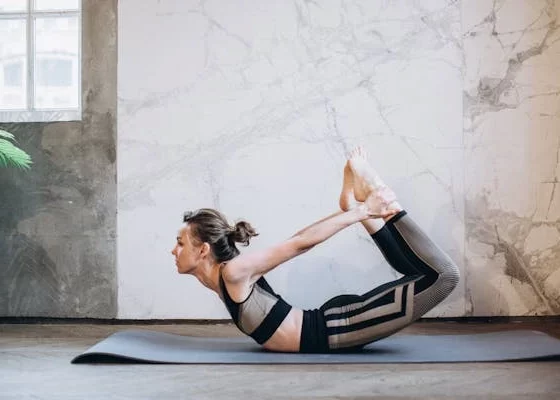Dancing is one of the enjoyable ways to stay fit and healthy. Indeed, incorporating an aerobic dance routine into your workout makes the exercise enjoyable and effortless. However, it does not settle with mere fun as a reason but assists in shedding excess weight, enhancing flexibility and balance, and elevating overall fitness levels. They offer a more engaging alternative to repetitive gym workouts while getting healthier and fitter. This article will tackle the five easy steps in losing belly fat through Aerobic Dance Exercises.
What are Aerobic Dance Exercises?
Dance aerobics, as the name implies, combines the rhythmic elements of aerobics with graceful dance movements. It can be categorized into four main types: high-impact exercises, low-impact exercises, step aerobics, and water aerobics. High-impact exercises involve vigorous jumping actions synchronized with the music’s rhythm.
Low-impact exercises, the second type of dance aerobics, feature less jumping and more footwork coordinated with the music’s rhythm. Step aerobics is executed using an elevated platform, whereas water aerobics occurs in waist-deep water. A dance aerobic session typically lasts about 20-30 minutes, with steps performed rhythmically, typically following 4 or 8 counts.
Dance aerobics offers an enjoyable way to enhance body strength and attain the energy required for practical daily activities. Explore the benefits of dance aerobics in the following paragraphs.
An aerobic dance exercise is any physical activity that induces sweating, increases heart rate, and elevates breathing above resting levels. It enhances cardiovascular health by strengthening the heart and lungs and improving oxygen delivery throughout the body. This rhythmic exercise engages large muscle groups and can continuously be sustained for at least 10 minutes.
Aerobic dance, rooted in dance-inspired motions, constitutes a cardiovascular exercise performed to music within a group setting. Instructors lead classes by verbally and visually guiding participants through choreography, eliminating the need to memorize routines. The aerobic nature of these classes involves engaging in full-body, rhythmic movements that activate large muscle groups.
The intensity level of an aerobic dance class is determined by the impact involved. The aerobic dance remains low-impact when one foot stays grounded during movements like knee lifts, heel touches, and floor slides. Conversely, if both feet leave the ground, even momentarily, through jumping, hopping, or jogging, it becomes a high-impact workout. Integrating more significant upper-body movements like arm swings, arm circles, and overhead reaches is advisable to boost the intensity of high-impact exercises without potential injury.
Aerobic dance takes place in a non-competitive setting. In the early 1980s, many classes avoided mirrors during the rise of aerobics. This environment aimed to shift the focus from physical appearances to individual abilities. Aerobic dance instructors design workouts emphasizing personal progress rather than competition among participants. Dancers enjoy these sessions to enhance their health, focusing solely on self-improvement.
An aerobic dance class typically follows a structured format. It starts with a warm-up dance lasting three to five minutes, slowly and gradually picking up speed over the next 30 to 45 minutes. During this time, you engage in dance-inspired movements that elevate your heart rate to your target zone. The routines can be choreographed or freestyle, depending on the instructor’s style. The session concludes with a three- to four-minute cool-down and stretching exercises.

What are the Benefits of Aerobic Dance Exercises?
You don’t need to rely solely on crunches and planks to achieve toned abs. Embrace your inner dancer to trim belly fat and unveil a sculpted midsection.
Belly fat responds positively to increased physical activity, and dancing offers an enjoyable boost to movement. Whether grooving in a Zumba class or swaying at home, you’re burning calories essential for trimming belly fat. Yet, shedding belly fat goes beyond aesthetics; it’s crucial for overall health. Excess belly fat, particularly the visceral fat surrounding your organs, heightens the risk of chronic conditions like Type 2 diabetes and heart disease.
Dance aerobic workouts strengthen the body, including weight-bearing bones and cardiovascular muscles. They facilitate weight loss, muscle building, and toning, making them suitable for individuals aiming to improve muscle definition.
This exercise is accessible to people of all ages and genders, providing an enjoyable fitness option. However, elderly individuals should limit the duration of training or take necessary precautions. It’s not recommended for very young children or pregnant women.
Engaging in aerobic dance routines improves blood circulation, lowers blood sugar and cholesterol levels, and enhances oxygen circulation to the heart, lungs, and blood vessels, promoting overall body function.
The workout enhances the efficiency of the heart and lungs while serving as a great stress reliever, diverting attention from daily monotony. It effectively alleviates depression, anxiety, and tension, contributing to mental rejuvenation.
Dance aerobics offer the flexibility to personalize dance steps according to individual preferences, such as jazz, disco, or hip hop, adding to the enjoyment of the activity.
Furthermore, dance aerobics serves as an effective means to boost the immune system, promoting overall health and well-being.
Although spot reduction isn’t possible, a University notes that your belly tends to slim down early on with increased activity. Movement enhances your daily calorie expenditure, creating a caloric deficit that prompts your body to tap into fat stores for energy.
Dancing is an engaging calorie-burning activity. For instance, a 155-pound individual can expect to burn around 223 calories in 30 minutes of fast-paced dancing, equivalent to a cross-country hike. Even slower dances like ballroom dancing still torch 205 calories in the same duration, while a leisurely waltz burns 105 calories — similar to a casual volleyball game. Additionally, individuals with higher body weights burn more calories while dancing.
With rhythm on your side, shedding those extra pounds becomes an enjoyable journey. Incorporate elements from hip-hop, belly dancing, and jazz into your routine to sculpt and tone your muscles effectively.
Hip Circle
Hip Circles is a belly dancing maneuver that focuses on engaging your obliques, the outer muscles of your abdomen, and your glutes. Enhance your experience by playing lively tunes that set the mood. A comparable motion to explore is the jazz hip-roll.
Hip circles present boundless creative opportunities. Experiment with speed, size, and direction to enhance the complexity of your performances. Allow your distinctive style to radiate through this foundational movement.
Step 1: Assume Your Position
Position yourself with your feet hip-width apart. Raise your arms gently to the sides of your body.
Step 2: Initiate the Action
Begin by shifting your hips from right to left to loosen them up.
Step 3: Engage in Circular Motion
Transition into a circular movement by shifting your hips to the right, back, left, and front. Repeat the sequence in the opposite direction. Sustain the motion for approximately 90 seconds.
Camel
Maintain your belly dancing rhythm with the Camel, a move designed to engage the front of your abdominal muscles, specifically targeting the rectus abdominis.
Step 1: Establish Your Position
Begin by standing with your feet hip-width apart. Arch your spine gently, pushing your chest forward while keeping your shoulders back and your arms relaxed at your sides.
Step 2: Engage Your Core
Counteract the arch by contracting your abdominal muscles, tucking your pelvis under, and allowing your shoulders to move slightly forward.
Step 3: Sustain the Ripple Effect
Maintain the ripple motion for approximately 60 to 90 seconds, keeping your movements fluid and controlled.
Hip-Hop Crunch
Crank up the hip-hop tracks and engage your rectus abdominis with this standing crunch that doubles as a trendy dance move.
Step 1: Assume Your Position
Begin by standing with your feet hip-width apart and placing your hands behind your head.
Step 2: Engage and Elevate
As you raise your right knee towards your chest, contract your abdominal muscles towards your spine. At the same time, crunch your upper body towards the knee. Repeat this sequence with the opposite leg.
Step 3: Establish Your Cadence
Discover a rhythmic pattern as you alternate between sides for one to two minutes.
Reach Down
Incorporate reach down movement into your hip-hop routine for a focused workout on your obliques.
Step 1: Position Yourself
Position yourself with your feet spaced hip-width apart and your hands behind your head.
Step 2: Assertive Reach
Release your right arm and extend it downwards towards your outer right knee, maintaining a side bend. Ensure your hips stay aligned with the front of the room, avoiding twisting.
Step 3: Sustained Motion
Repeat the action with your left arm. Alternate sides for one to two minutes.

Belly Roll
Inspired by belly dancing but adaptable to a hip-hop rhythm, the belly roll adds flair to your routine. Mastering this move takes practice, focusing on engaging your rectus abdominis.
Step 1: Assume Your Position
Stand with your feet hip-width apart, and let your arms drift slightly behind you.
Step 2: Inhale and Broaden
Inhale deeply, expanding your rib cage while engaging the lower section of your abdomen.
Step 3: Relax Your Midsection
Exhale gently, allowing your lower belly to expand while contracting the upper abdominal area.
Step 4: Sustain the Undulation
Alternate between these motions to generate a flowing, wave-like action. Aim to gradually extend the duration to 30 seconds or more as you practice.
Apart from these aerobic dance exercises, maintaining a proper diet could impact losing belly fat. Hence, monitor your portion sizes and the nutritional quality of your food selections to reduce belly fat effectively. Restrict intake of sugary treats, such as soda and refined grains.
Conclusion:
In the contemporary competitive environment, many individuals need help finding time for physical activities like exercise, even though staying in excellent shape is one of their top priorities. Thus, aerobic dance exercises and eating proper meals regularly could help lose excess weight and unnecessary belly fat.


